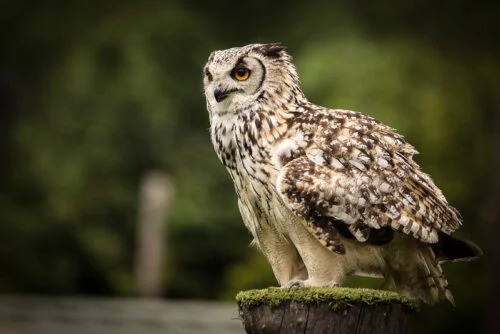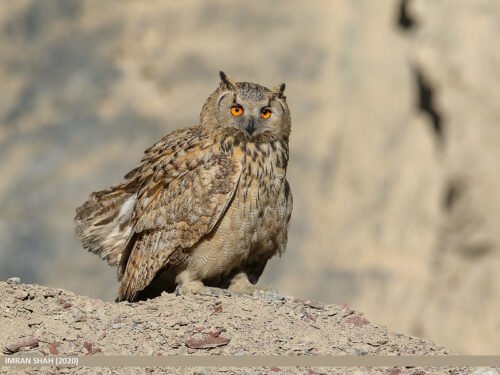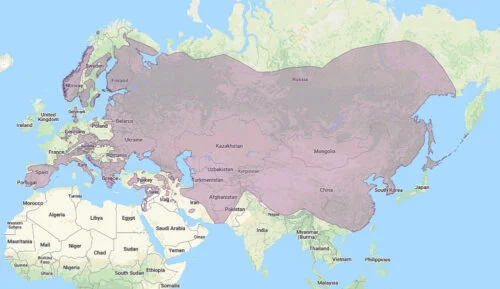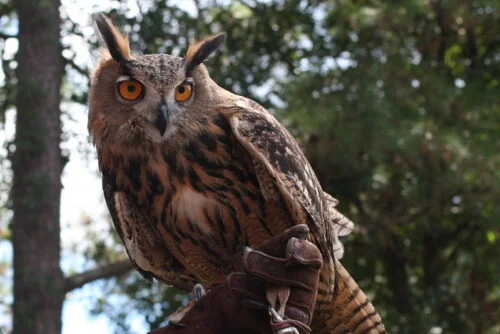The world’s heaviest owl, the Eurasian Eagle-Owl (Bubo bubo), is a fascinating and majestic creature.
With its impressive size, striking features, and formidable hunting abilities, this owl species captivates bird enthusiasts and casual observers alike.
In this article, we will explore the key characteristics, habitat, diet, and conservation status of the Eurasian Eagle-Owl, shedding light on the world’s heaviest owl and its significance in the ecosystem.
What is the world’s heaviest owl species?

The Eurasian Eagle-Owl is the world’s heaviest owl species. These powerful birds can weigh up to 4.5 kg (10 lbs) for females and 2.7 kg (6 lbs) for males, with a wingspan of up to 188 cm (74 inches). Their striking appearance, with their large orange or yellow eyes, prominent ear tufts, and impressive size, sets them apart from other owl species.
What are the key characteristics of the world’s heaviest owl?
Apart from their significant size and weight, the Eurasian Eagle-Owl has several other key characteristics that make them unique:
- Large orange or yellow eyes, which provide excellent night vision for hunting
- Prominent ear tufts that serve as a camouflage mechanism and help them communicate with other owls
- Strong, curved beak for tearing apart prey
- Powerful talons for gripping and killing prey
- Soft, dense feathers muffle the sound of their wings, allowing them to fly silently

Where can the world’s heaviest owl be found in the wild?
The Eurasian Eagle-Owl has a widespread distribution, spanning across Europe, Asia, and parts of North Africa.
They can be found in various habitats, including forests, mountains, rocky cliffs, and even urban areas.
However, they prefer remote and undisturbed locations for nesting and breeding.

How does the world’s heaviest owl compare to other large owls?
The Eurasian Eagle-Owl is larger and heavier than other owl species, such as the Great Horned Owl and the Snowy Owl. While the Great Horned Owl has a similar wingspan, it typically weighs less. The Snowy Owl, known for its distinctive white plumage, also weighs less than the Eurasian Eagle-Owl. These differences in size and weight contribute to the Eurasian Eagle-Owl’s exceptional hunting skills and adaptability to various environments.

What adaptations allow the world’s heaviest owl to thrive in its environment?
The Eurasian Eagle-Owl’s adaptations enable it to thrive in its natural habitat:
- Excellent night vision and hearing, which help them locate and track prey in low-light conditions
- Silent flight, made possible by their soft, dense feathers, giving them the element of surprise when hunting
- Powerful talons and beak for capturing and consuming prey
- Camouflaging plumage and ear tufts to blend in with their surroundings and avoid detection
How does the world’s heaviest owl hunt and what is its diet?
The Eurasian Eagle-Owl is a formidable hunter, employing stealth and precision to catch its prey. Hunting primarily at dusk and during the night, these owls use their exceptional night vision and acute hearing to locate prey in low-light conditions.
Their soft, dense feathers allow for silent flight, enabling them to approach their prey undetected.
The Eurasian Eagle-Owl’s diet consists mainly of small mammals like rabbits, hares, and rodents.
They also consume birds, reptiles, amphibians, and occasionally, fish and insects. Their powerful talons and strong beak enable them to capture and consume a wide range of prey species.
Are there any specific mating and nesting behaviors unique to the world’s heaviest owl?
The Eurasian Eagle-Owl exhibits some unique mating and nesting behaviors. During the mating season, the male owl performs a courtship display to attract a female. This display consists of vocalizations, wing-clapping, and aerial acrobatics.
Once a pair has formed, they engage in mutual preening and share food as part of their bonding process.
Eurasian Eagle-Owls prefer to nest in remote and undisturbed locations, such as rocky cliffs, crevices, or caves.
They may also use abandoned nests of other large birds, like raptors. The female usually lays 1-4 eggs, which she incubates for 34-36 days.
The male provides food for the female during this period. After hatching, the chicks remain in the nest for about 5-6 weeks, relying on their parents for food and protection. The young owls eventually leave the nest but may continue to receive parental care for several more months.
What is the conservation status of the world’s heaviest owl and what threats do they face?
The Eurasian Eagle-Owl is classified as a species of “Least Concern” by the International Union for Conservation of Nature (IUCN) due to its wide distribution and stable population.
However, in some parts of its range, the owl faces threats that could impact its future survival.
These threats include habitat loss and fragmentation due to deforestation, urbanization, and infrastructure development, as well as illegal hunting, poisoning, and human disturbance. Climate change could also affect the owl’s habitat and prey availability in the long term.
